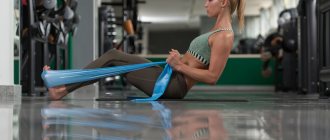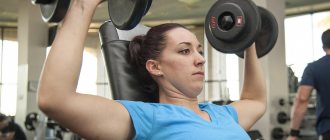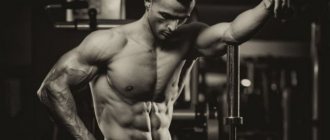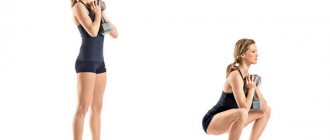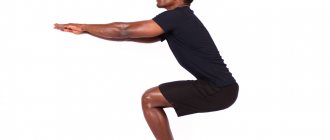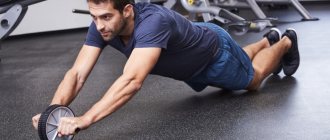Statics: features
Static exercises are training designed in such a way that contraction of the target muscles occurs without causing them to move. In other words, the muscles actively work to hold the body in a stationary position.
Such exercises for working out the abs are successfully used in training programs aimed at losing weight.
Undoubtedly, dynamic exercises (including the familiar crunches) are effective and worth doing. However, in order to diversify the training process and give the muscles an unusual load, static exercises are good.
Static abdominal training
The principle of static training is fixation of the body in a certain position. Ligaments and muscles, even the smallest and deepest, receive severe tension. During execution, the main emphasis is on the target muscle group, but part of the load is taken by the rest of the body (body, arms, legs). A static set of abdominal exercises at home is an ideal option for pumping up your core.
It is not the repetitions of movements that are counted, but the time in poses. There are 10 exercises in total, 1 minute for each exercise. Choose the exercise option (simple or difficult) that you can do.
Lesson plan:
- Forearm plank on one leg: 20 seconds on the right and left side, 10 seconds rest
- Boat pose: 40 seconds exercise, 20 seconds rest
- Side plank with emphasis on the elbow: 20 seconds on the right and left sides, 10 seconds rest
- “Hunting dog”: 20 seconds on the right and left sides, 10 seconds rest
- Stand on all fours: 20 seconds on the right and left sides, 10 seconds rest
- Corner: 40 seconds exercise, 20 seconds rest
- Straight arm side plank: 20 seconds on the right and left sides, 10 seconds rest
- Reverse plank: 40 seconds exercise, 20 seconds rest
- Superman: 40 seconds exercise, 20 seconds rest
- Straight arm plank: 20 seconds on the right and left sides, 10 seconds rest
See also:
- 10-Minute Back Relaxation Workout: 10 Easy Exercises
- 10 Minute Posture Workout: 10 Back Exercises
Single Leg Forearm Plank
How to do a simple version: Get on your knees, do not lower your pelvis, bend over and place your hands on your forearms in front of you. Leave the distance between your elbows at shoulder level, and move your palms slightly towards each other. Next, stretch your legs back and assume a plank pose. Keep your body straight and tuck your buttocks. Place one foot with the toe on the heel of the other. Do not bend your knee joints. Tighten your abdominal muscles.
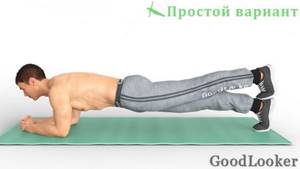
How to perform the difficult version: Holding the pose is more difficult, since the support is transferred to only one leg. Stand in a standard plank position with emphasis on your forearms and elbows. Raise one leg 30-40 cm. Keep the body from the head of the lower leg in the same plane. Don't bend over backwards. This at-home abdominal exercise works great on stabilizers.
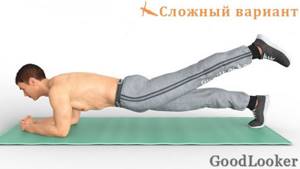
Boat pose
How to do the simple version: Lie on your back and stretch well. Keep your legs together, straighten your elbows and place them on the floor above your head. Work through your abdominal muscles, this is the only way to get the maximum benefit. Tear off a little of the shoulder blades, neck, head and arms, keep on the line. At the same time, raise your legs higher, up to a 45-degree angle to the floor. Tighten your abs and slightly round your thoracic back.

How to do the hard version: Start by assuming the same pose as the easy version. Lie on your back, legs and arms extended. Next, do the same movements. Remaining on your lower back and buttocks, raise your arms with your shoulder blades and head. Tear off your legs to a small height - 10–20 cm. This is the difficulty. The smaller the lift from the floor, the stronger the press works.
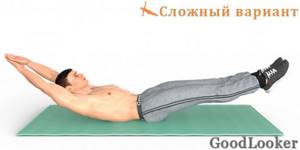
Side plank with elbow rest
How to do the simple version: Lie on your side with your legs next to each other. Place your arm underneath you, placing your elbow level with your upper chest and resting your forearm on the floor. Stretch out, keep a line from head to heels, straighten your knees. Place your foot on top of your foot, your free hand on your waist. Lift your pelvis up without changing the position of the rest of your body.
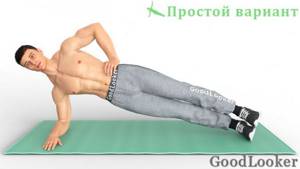
How to perform the difficult version: Take the starting position from the plank variation for beginners - lean on your elbow, stretch out, straighten your knees, place your feet on top of your feet. Look ahead. Raise your pelvis and upper leg. Leave a sharp angle between your thighs. Keep your body from the head to the foot of the supporting leg in a single line. To stand in this static abdominal exercise will require tremendous effort.
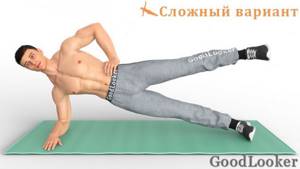
"Hunting dog"
How to do the simple version: Get on your knees and place your palms on the floor in front of you. Place your hips and arms perpendicular to the surface, keeping your knees at a right angle. Straighten one leg, lift it parallel to the floor, freeze, then lower it and repeat with the other leg. Keep your lower back slightly arched, do not move your arms and body, look straight ahead.
Benefits of static abdominal exercises
- To train, you don’t have to go to a gym where there is special equipment. It can be successfully performed at home.
- The exercise will take little time, but will create maximum stress on the abdominal muscles, which are accustomed to standard crunches.
- After classes, you will not feel tired, since during the exercises you will not expend energy on performing the movement, but will concentrate on working the abdominal muscles.
- Once you get used to the new load, if you wish, you can combine static exercises with other activities, for example, watching TV or reading books.
- Static gymnastics is especially recommended for people who have health problems that limit the ability to perform a number of dynamic exercises. For example, some types of crunches place a lot of stress on the spine. Static exercises are safer in this regard.
Seated ab workout. Static exercises
When performing this exercise, you physically feel the evaporation of fat from the abdominal area.
The burning sensation is serious, tested for yourself! Even heavyweight people can slim down their waist in just a few weeks. Without any diets.
If you are unable to hold the exercises for at least a few seconds, try other abdominal exercises until you get into shape.
At each workout, try to increase the exercise time by at least one second and gradually build it up to a minute. And then up to a few minutes
Just pump your abs in this manner at the very end of your workout.
Shall we turn on some music to set the mood?
Now playing:
Open Kluber FM website | iOS app | Android app
Surprise your abs: effective static exercises
Let's look at the most effective abdominal exercises performed statically.
Plank
Take a position on all fours, resting your palms or forearms on the floor (these are different variations of the same exercise, use both, changing them from time to time to avoid muscle addiction). Place your hands at a comfortable distance, approximately shoulder width apart. Palms face forward. The legs rest on the floor with the toes and are also spread shoulder-width apart.
Important: the body should be a straight line and resemble an elongated string - this is the main condition for the correct execution of the plank. Do not sag down or arch upward, this will reduce the effectiveness of the exercise and put unnecessary stress on your back.
You need to “hang” in this position for at least 20-30 seconds. Gradually add time, ideally up to 5 minutes.
When it becomes easy to hold in this position for several minutes, move on to more complex plank variations.
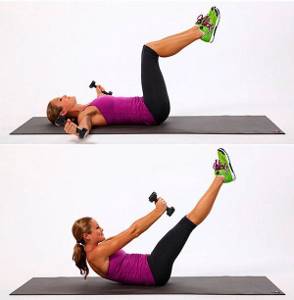
Side plank with elbow support
Lie on your side, rest your elbow on the floor. Raise your body up so that the top of your supporting arm and shoulders are in one line. The body should not sag down, the stomach should not be tense. Try to hold this for 30 seconds and do the same on the other side.
A variation of the exercise is a side plank supported by an outstretched arm. It works the same way.
Single leg plank
Take the position as for the classic elbow plank. Having secured yourself, lift one leg off the floor and pull the toe toward you. Don't forget to keep your body level! Stay in this position for as long as possible and change legs.
Leg raise with fixation
The exercise perfectly works the abs with an emphasis on the lower part. Lie on your back, fix your hands behind your slightly raised head. Raise your extended legs approximately 20-30 cm from the floor (45° angle. Hold in this position as long as your physical fitness allows.
This exercise puts stress on the lower back, so it is not recommended for people with spinal health problems.
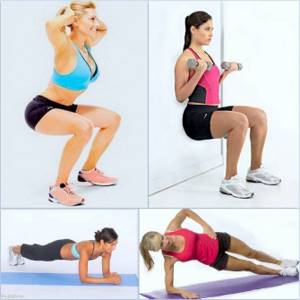
Top 7 static abdominal exercises
The best isometric movements for the abdominal area.
Keeping your legs raised while sitting
Despite its simplicity, this movement is considered one of the best. It perfectly works the entire abdominal mass, with an emphasis on the rectus muscle. Also, its main advantage is that the muscles are held in a bent position, that is, when the rectus abdominis muscle is already contracted.
Technique:
- Sit on the floor, lean back and rest on your elbows.
- Bring your legs together and lift them up at a 30-degree angle.
- Hold the position for as long as possible.

To make it more difficult, increase the angle of your legs or lie with your back on the floor (hands behind your head).
Plank
The most common exercise. The plank works well on the abdominal area, but has a disadvantage - the load is distributed to other muscles, especially if you stand in the pose for more than 60 seconds.
Technique:
- Take emphasis on your elbows and toes. Round your back slightly so that your stomach is slightly curled.
- Hold the position for 40-60 seconds (or until you are completely tired).

The main rule is that the body should not be straight. With this position, the load falls more on the lower back and back, which can cause certain problems. To switch focus to the abs, you need to slightly bend your body so that the rectus abdominis muscle is more engaged.
To make it more challenging, do the pose on one leg.
boat
A very difficult exercise that, with the right approach, can easily “kill” the abs even in advanced athletes.
Technique:
- Lie on the floor, bring your arms and legs together. Raise your arms up at an angle of 30-40 degrees, legs - 45-50 degrees.
- Hold the position, tensing your abdominal muscles for as long as possible.
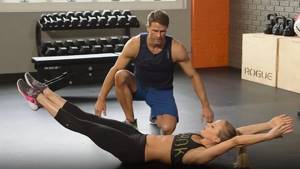
To make the task more difficult, lower your legs slightly; the closer they are to the floor, the more difficult the exercise will become.
Side plank
Similar to a regular plank, but with an emphasis on the oblique abdominal muscles.
Technique:
- Rest on your elbow (biceps perpendicular to the floor) and feet, sideways towards the floor. The body forms a straight line.
- Hold the position throughout the entire approach.
- Repeat the same timed set on the other side.

More about the side plank →
Plank with emphasis on the wall
An advanced version of the plank. Its difference is that your feet must be rested against the wall. The body is parallel to the floor, which creates additional stress on all muscles. It is extremely important to use soft pillows or cushions at first, as your feet may slip.

Twisting against the wall
One of the most grueling exercises for the abs. Unlike other positions, in this movement the load is held in the abs while the muscles are contracted.
Technique:
- Rest on your hands so that your pelvis is in the air. Bring your legs together and press them against the wall so that your feet are level with your face. The hips are pressed to the body.
- Hold the position until you are completely tired or for the allotted time.
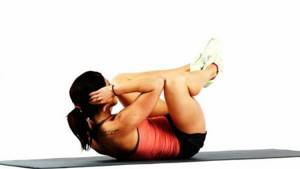
Reverse plank
This exercise acts more as a pose for working all the core muscles, and not specifically the abs. Its advantage in uniform load makes this variation of the bar very useful.
Technique:
- Place your palms on the floor with your arms straight. Place your feet forward and rest on your heels. The body should form a straight line, the head and neck in a neutral position (do not lift forward, this will lead to overbending in the cervical region).
- Hold the position throughout the entire set.

It is important to ensure that the pelvis does not sag downwards, this will significantly reduce the benefits of the position for the abdominal muscles. Also, additionally try to concentrate the load on the press.
Read more about the reverse plank technique →
